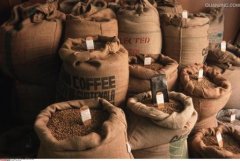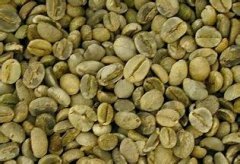A brief introduction to the flavor, taste and aroma characteristics of Ecuadorian boutique coffee beans with balanced and refreshing taste

Ecuadorian coffee has distinctive South American coffee characteristics. The fragrance was soft, as if it could go back to the ancient and mysterious Inca Empire. Coffee is a good history, and you need to savor it carefully to understand the vicissitudes.
Balanced low acidity, aromatic and rich. The bitterness is not obvious, the taste is clear, but there is a lingering aftertaste lingering for a long time. Superior environment created coffee crisp character, and coffee farmers enthusiasm and endow coffee enthusiasm of life.
This kind of high-quality coffee is not enjoyed by all friends. I hope Ecuador will one day be as famous as the banana country.
Known as the country of coffee, Ecuador, which passes through the equator between Colombia and Peru, is one of the few countries in South America that produces both Arabica coffee and robasta coffee.
Ecuador actually means "equator" in Spanish. Due to the use of old-fashioned traditional harvesting and processing methods, Ecuadorian coffee is not listed as fine coffee and is therefore generally less visible.
Ecuador faces the Pacific Ocean, about 900 kilometers off its west coast near the equator at 90 degrees west longitude, there is a Galapagos Island (Galapagos Island) is also its territory, also known as Colón Island, producing the famous Galapagos coffee. In order to protect the natural ecology, the Ecuadorian government has designated the archipelago as a national park, and banned the use of chemical fertilizers, pesticides and other chemicals, so the coffee in the Galapagos Islands is recognized as organic coffee.
Galapagos coffee is balanced and neutral, with a medium body, a distinct but pleasant acidity, and a distinctive aroma. However, since it is rarely seen in the market, not many people talk about this coffee.
In the mid-15th century, among fishermen fishing in the Pacific Ocean off western South America, there were legends of magical islands. It is said that the islands can sometimes be clearly seen from a distance, but disappear as the ship approaches; sometimes they look like a galleon, sometimes they take on the shape of a witch. Fishermen called the islands "the enchanted islands," thinking they might be ruled by demons like the banshees of the sea in the Odyssey. This island, known to fishermen as the "magic island," is today the Galapagos Islands.
In 1535, the Galapagos Islands were discovered by chance by Frei Thomas de Berlanga of Spain and others. Thomas was born in 1487 on the banks of the Duro River in the Spanish province of Soria. He was the fourth bishop of Panama at that time. He was ordered to Peru. When his ship set out from Panama on February 23, under the impact of a strong current, they were carried to an unknown sea in the outer ocean. On March 10, an island in the Galapagos Islands was discovered. With only two days of fresh water left on board, the sailors landed in lifeboats and found plenty of seals, turtles, giant tortoises that could carry people and viper-like iguanas on the island, but they could not find fresh water, so they headed for another larger island more than 20 kilometers away. As there was still no wind, it took them days to get there, the water ran out quickly, and they had to starve, including the horses on board.
When Thomas and his crew landed on the island, they frantically searched for water and were so thirsty that they squeezed juice from the fat petals of cacti to drink. Finally found water in a ravine in a rock. Thomas attributed it to God because it was Good Friday and they had celebrated Mass piously before setting out in search of water. Thomas would never have known, however, that the island they landed on was the only one in the Galapagos with plenty of fresh water, today's Saint Cristobal.
San Cristobal is a large island in the Galapagos Archipelago. At an altitude of 410 meters, there is a small lake called El Junco. The lake forms several streams flowing along the rocks and volcanic rocks on the southern slope of the island. Fresh water rich in minerals nourishes the land of San Cristobal, making the soil here always moist and fertile. It provides the most rare conditions for the growth of coffee here.
In 1875, 340 years after Frey Thomas de Berlanga discovered the island, an indigenous man named Cobos arrived on San Cristobal Island, where he established the Hassenda coffee plantation and planted about 100 hectares of arabic bourbon trees. Because the plantation is located between 140 meters and 275 meters above sea level, the climate is equivalent to the climate between 915 meters and 1830 meters inland, and the unique geographical conditions are very suitable for the growth of high acidity super hard coffee beans (SHB), so this high quality coffee is settled here. Ecuador is located in South America, and the equatorial line passes through the country. Therefore, Ecuador is also known as the "Equatorial Country". Ecuador's superior geographical location, Ecuador is one of the few countries in the world that produces both Arabica and Robusta coffee beans, thanks to its fertile soil and exceptional climatic conditions.
When it comes to Ecuadorian coffee, you have to mention the organic coffee of the Galapagos Islands in Ecuador. Galapagos Islands is a famous tourist attraction, declared by UNESCO as "World Natural Heritage", extremely rich in products, organic coffee is one of the unique. Organic coffee in the Galapagos Islands is recognized as a natural green specialty coffee due to its unique ecological environment such as fertile volcanic soil and microclimate, coupled with its cultivation method without using any fertilizers and pesticides. This naturally grown coffee is mild in taste, with hints of grass, flowers and caramel, and is highly sought after by merchants and coffee lovers.
Creative coffees made from Ecuadorian coffee beans with unique aromas are also popular with consumers. Mr. Veniso, winner of the 2014 Ecuadorian Coffee Competition, won the Ecuadorian Coffee Competition with his creative formula. One espresso is fresh and unique with mint from the Amazon, and the other is fragrant with Ecuadorian rose petals, the Rolls Royce of Roses, that coffee lovers can't stop admiring
Galapagos coffee is recognized as green natural coffee because the Ecuadorian government has designated the archipelago as a national park, which not only no longer allows new agricultural land, but also prohibits the use of chemical fertilizers, pesticides, herbicides and other chemicals. Although the altitude of about 200m on the island is very low, it is specially affected by the ocean. The climate in this area is equivalent to that of 1000m-1800m on land, which is very suitable for the growth of coffee, especially the quality of super hard coffee (SHB).
Ecuador also produces coffee locally. Because the Andes pass through from the middle, coupled with sufficient precipitation, suitable temperature and abundant light under the influence of tropical climate, Ecuador's coffee grows very well. Gigante and Galapagos coffee are the best of coffee, although Arabica coffee has not been grown in Ecuador for long.
Important Notice :
前街咖啡 FrontStreet Coffee has moved to new addredd:
FrontStreet Coffee Address: 315,Donghua East Road,GuangZhou
Tel:020 38364473
- Prev

A brief introduction to the treatment method of grinding degree and baking degree of Cupid coffee beans with bright taste
The Baru volcano is not only the highest mountain in Panama, but the sediments created by early volcanic activity and eruption bring a large amount of very fertile soil, which is rich in nutrients, especially rich in phosphorus and sulfur, mixed with clay, coupled with a unique climate model, to form an environment suitable for the growth of high-quality coffee, dense forests and a large number of dense forests.
- Next

A brief introduction to the history and culture of the origin and development of balanced and refreshing Ecuadorian boutique coffee beans
Galapagos Islands coffee is recognized as green natural coffee, because the Ecuadorian government has designated the islands as a national park, not only does it no longer allow the reclamation of new agricultural land, but also forbids the use of chemical fertilizers, pesticides, herbicides and other chemicals. Although the elevation of about 200m on the island is very low, the climate of this area is equivalent to terrestrial 1000m1800m due to the special influence of the sea.
Related
- Detailed explanation of Jadeite planting Land in Panamanian Jadeite Manor introduction to the grading system of Jadeite competitive bidding, Red bid, Green bid and Rose Summer
- Story of Coffee planting in Brenka region of Costa Rica Stonehenge Manor anaerobic heavy honey treatment of flavor mouth
- What's on the barrel of Blue Mountain Coffee beans?
- Can American coffee also pull flowers? How to use hot American style to pull out a good-looking pattern?
- Can you make a cold extract with coffee beans? What is the right proportion for cold-extracted coffee formula?
- Indonesian PWN Gold Mandrine Coffee Origin Features Flavor How to Chong? Mandolin coffee is American.
- A brief introduction to the flavor characteristics of Brazilian yellow bourbon coffee beans
- What is the effect of different water quality on the flavor of cold-extracted coffee? What kind of water is best for brewing coffee?
- Why do you think of Rose Summer whenever you mention Panamanian coffee?
- Introduction to the characteristics of authentic blue mountain coffee bean producing areas? What is the CIB Coffee Authority in Jamaica?

